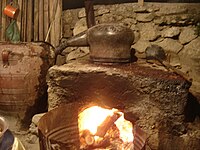

Tsikoudia (Greek: τσικουδιά, romanized: tsikoudiá, literally "terebinth") is a traditional alcoholic beverage and pomace brandy from the Greek island of Crete. It contains 40% to 65% alcohol by volume (ABV).
Production and Process
Tsikoudia is made by distilling pomace (the residue of pressed grapes left after winemaking). The pomace ferments for approximately six weeks in sealed barrels, ensuring the natural sugars are converted into alcohol. The resulting mixture is then distilled in copper stills, known locally as kazani (καζάνι).
Unlike many other Mediterranean pomace spirits, tsikoudia undergoes a single distillation process, preserving the original grape aroma and flavour. This contrasts with double-distilled counterparts like tsipouro or rakı, which often incorporate additional flavourings such as anise.
History and Cultural Significance
The name tsikoudia derives from the Greek word for terebinth, referencing the plant’s historic use in flavouring spirits. In eastern Crete, it is colloquially known as raki (Greek: ρακή, romanized: rakí), a term borrowed from Turkish rakı and itself from Arabic arak (عرق), both meaning "distilled." This nomenclature reflects the Ottoman influence on the island during the 17th century.
Tsikoudia is deeply embedded in Cretan culture, symbolising hospitality and celebration. It is traditionally produced at home in villages, with distillation rights often passed down through generations. Typically, each village has one or two licensed distillers who oversee production during late October and early November.
Consumption
Tsikoudia is almost always served chilled, often straight from the freezer. It is commonly offered as a complimentary digestif in Cretan restaurants, accompanied by fresh fruits, nuts, or sweets like loukoumades (honey-soaked doughnuts) or halva.
Similar Spirits in the Mediterranean
Tsikoudia is part of a broader family of grape-based spirits in the Mediterranean, including tsipouro from mainland Greece, orujo from Spain, grappa from Italy, marc from France, Georgian: chacha from Georgia, and rakia from the Balkans. However, its single distillation process and lack of added spices give tsikoudia a unique profile that distinguishes it from these spirits.
Notes
- "Tsikoudia, the Cretan Spirit". We-Love-Crete.com. Retrieved 27 July 2014.
- "Tsikoudia". Encyclopedia Britannica. Retrieved 22 November 2024.
- Kritikos, Nikos (2019). Traditional Beverages of Crete. Cretan Publishing. pp. 45–47.
- Stefanoudakis, Manolis (2020). "Distilled Spirits of Greece". Gastronomy Journal. 12 (4): 234–237. doi:10.1080/987654321.
- Clogg, Richard (2013). A Concise History of Greece. Cambridge University Press. pp. 89–92.
- "The Art of Tsikoudia Production". Cretan Gastronomy. Retrieved 22 November 2024.
- Papadakis, Ioannis (2021). "Cretan Culinary Practices". Journal of Mediterranean Cuisine. 15 (2): 78–85.
- "Comparing Mediterranean Pomace Brandies". Distilled Spirits Council. Retrieved 22 November 2024.
See Also
Portals:| Alcoholic beverages | |||||||||||
|---|---|---|---|---|---|---|---|---|---|---|---|
| |||||||||||
| |||||||||||
| |||||||||||
| |||||||||||